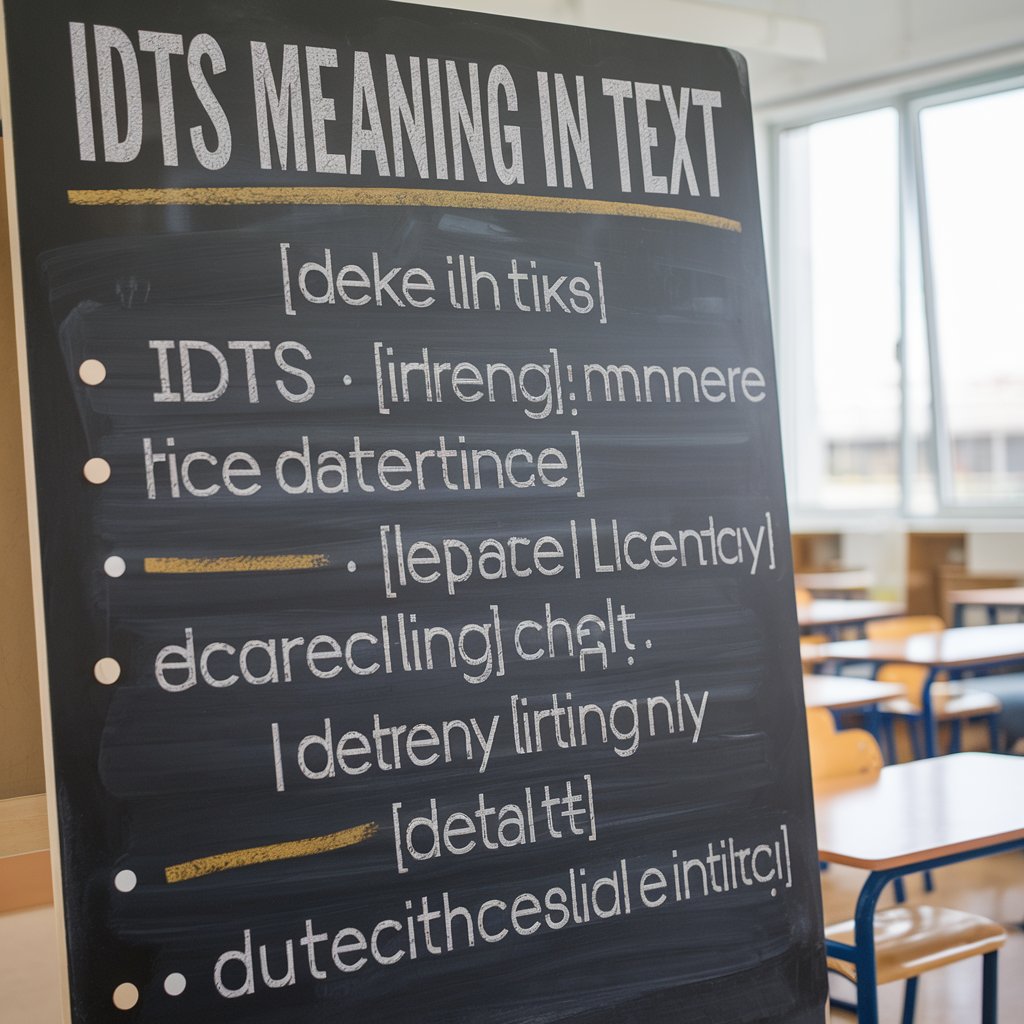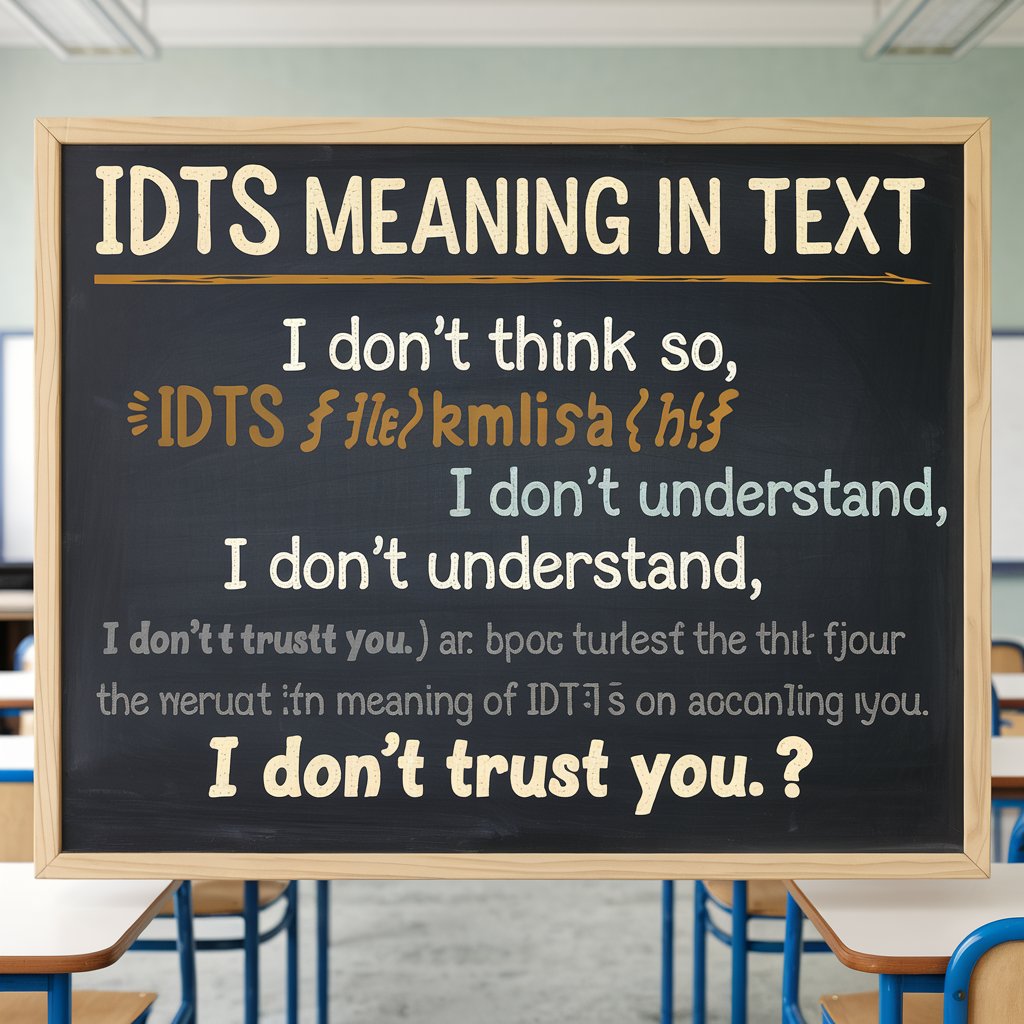Understanding IDTS Meaning and Usage in Texting
In today’s fast-paced digital world, acronyms have become a vital part of communication, especially in texting. One such acronym that has gained traction is “IDTS, meaning in text” which stands for “I Don’t Think So.”
This simple yet effective phrase allows users to convey skepticism or disagreement quickly, fitting seamlessly into various conversational contexts. This comprehensive guide will delve deeply into the meaning, usage, significance, and cultural impact of IDTS meaning in text.
read more : “Casi Algo” Meaning, Usage, and Cultural Insights – Grammar Beacon
What Does IDTS Meaning in Text?
Definition and Explanation
At its core, IDTS serves as a concise way to express doubt or disagreement. The phrase “I don’t think so” encapsulates a personal opinion in a straightforward manner.
Using IDTS enables speakers to communicate effectively without needing extensive elaboration, making it particularly useful in informal settings.

Characteristics of IDTS:
- Brevity: IDTS condenses a complete thought into just four letters, catering to the need for quick responses in texting.
- Informality: The acronym fits comfortably within casual conversations, making it an ideal choice among friends or peers.
- Cultural Relevance: As language evolves, IDTS reflects a shift toward more direct and informal forms of communication.
Importance of IDTS meaning in text in Digital Communication
Understanding the significance of IDTS in the context of modern communication can illuminate its widespread usage. Here are a few key points highlighting its importance:
- Efficiency: The ability to communicate a disagreement succinctly helps maintain the flow of conversation, especially in fast-paced exchanges.
- Casual Tone: IDTS contributes to a relaxed atmosphere in conversations, fostering comfort and familiarity among participants.
- Cultural Connection: As a part of youth slang, IDTS resonates particularly well with younger audiences, reflecting shared values and communication styles.
Recognizing these facets can enhance your understanding of why IDTS has found a solid place in digital vernacular.
When and How Is IDTS Used?
Contexts and Scenarios
IDTS can be applied in various contexts, and knowing when and how to use it can improve your texting skills. Below are common scenarios where IDTS is often employed:
Casual Conversations: Friends frequently use IDTS when discussing plans or ideas, allowing for light-hearted exchanges.
Example:
Friend 1: “I think we should go to the beach this weekend.”
Friend 2: “IDTS! It’s supposed to rain.”
Debates and Discussions: IDTS is effective in more serious conversations, such as debates on social issues, where participants express differing opinions.
Example:
Colleague: “We should definitely allocate more resources to social media.”
You: “IDTS; our analytics show it’s not effective.”
Responses to Suggestions: When someone proposes an idea that seems impractical, IDTS allows for an immediate yet respectful reaction.
Example:
Sister: “How about we start a YouTube channel?”
You: “IDTS; I don’t have the time for that.”
Social Media Interactions: In the realm of social media, where comments are often brief, IDTS captures skepticism efficiently.
Example:
User 1: “This new diet is the best!”
User 2: “IDTS; I tried it and felt awful.”
Understanding these scenarios showcases the versatility of IDTS across different contexts.
like more : “El Belicon” Meaning, Usage, and Cultural Significance – Grammar Beacon

Examples of IDTS in Conversations
Real-Life Texting Examples
To provide clarity on how IDTS operates in real-life interactions, let’s look at specific texting examples across various situations:
Group Chat:
Friend 1: “I heard that new restaurant is amazing!”
Friend 2: “IDTS. The reviews weren’t good.”
Family Texts:
Dad: “I think you should apply for that job.”
You: “IDTS. It’s not a good fit for me.”
Workplace Messaging:
Manager: “We need to start focusing more on social media strategies.”
You: “IDTS; our previous campaigns haven’t performed well.”
Social Media Comments:
User 1: “I think this movie is overrated!”
User 2: “IDTS! It’s one of the best films this year.”
These examples demonstrate IDTS’s practical applications, illustrating how it seamlessly integrates into everyday conversations.
The Meaning Behind IDTS
A Deeper Look into Its Significance
The phrase IDTS represents more than just a casual expression of disagreement; it reflects broader cultural and social dynamics. Here are some elements that contribute to its significance:
- Cultural Relevance: IDTS resonates with youth slang, serving as a marker of identity among young people. It encapsulates their values, beliefs, and the way they navigate interpersonal relationships.
- Impact on Relationships: Using IDTS can signal familiarity and comfort in conversations. It indicates that the speaker feels secure enough to express dissent, which can strengthen social bonds.
Understanding the underlying significance of IDTS provides insight into its popularity and continued usage.
like more : YWA Meaning in Text? – Grammar Beacon
What Does IDTS meaning in text Stand For?
Breakdown of the Acronym
To fully grasp the essence of IDTS, let’s dissect the acronym itself:
- I: Represents a personal viewpoint or opinion.
- Don’t: Conveys refusal or disagreement with the preceding statement.
- Think: Suggests contemplation or consideration of the idea being challenged.
- So: Emphasizes the disagreement that follows.
This breakdown illustrates how IDTS encapsulates a complete thought in just four letters, reflecting the efficiency valued in texting.
Common Misunderstandings of IDTS
Clarifying Misconceptions
Despite its simplicity, several misunderstandings about IDTS can arise:
- Overuse: New users may believe that IDTS conveys only strong disagreement, while it can also express mild skepticism or doubt.
- Context Sensitivity: Users might misuse IDTS in formal contexts, leading to potential misinterpretations or awkwardness.
Clarifying these misconceptions is essential for effective communication and ensures that IDTS is used appropriately.
The Origin of IDTS
Historical Context and Evolution
The emergence of acronyms like IDTS illustrates the evolution of language in digital communication. Understanding its origins sheds light on its relevance today:
- Early Texting Culture: As texting gained popularity in the early 2000s, users sought efficient ways to communicate. Acronyms emerged as a natural response to character limits and the need for quick exchanges.
- Influence of Social Media: Platforms like Twitter and Instagram, which have character constraints, have further propelled the adoption of abbreviations, including IDTS.
These historical insights provide context for IDTS within the broader landscape of internet slang.
Essential Insights About IDTS
Key Takeaways for Texting Etiquette
Using IDTS effectively involves understanding its nuances. Here are essential insights to consider when incorporating IDTS into your conversations:
- Know Your Audience: Reserve IDTS for casual conversations with friends or peers. Avoid using it in professional communications where a more formal tone is required.
- Tone Matters: Consider the tone of the conversation; using IDTS may come off as dismissive if not used thoughtfully. It’s crucial to gauge the mood before deploying this acronym.
- Context is Key: Ensure that IDTS fits the context of your discussion, whether casual or serious. Misusing it could lead to misunderstandings or unintended offense.
By adhering to these guidelines, you can incorporate IDTS into your conversations seamlessly and effectively.
Trends in Internet Slang and IDTS
The Evolution of Internet Slang
As language continues to evolve in the digital age, IDTS is just one of many terms shaping our communication. Internet slang trends often arise from popular culture, memes, and social media phenomena. Here are some notable trends:
- Acronyms and Abbreviations: The prevalence of acronyms like IDTS, LOL (laugh out loud), and BRB (be right back) exemplifies the shift toward concise communication.
- Emojis and GIFs: Visual elements have become essential in digital conversations, allowing users to convey emotions quickly and effectively.
IDTS in Different Platforms
IDTS is used across various platforms, each offering unique ways to express this acronym. Understanding how it functions in different settings can enhance your digital communication skills:
- Text Messages: Quick exchanges in personal conversations often feature IDTS, reflecting the need for speed and efficiency in casual chats.
- Social Media: On platforms like Twitter and Instagram, IDTS can succinctly comment on posts or replies, maintaining a conversational tone without lengthy explanations.
- Forums and Group Chats: In discussion forums or group chats, IDTS helps articulate opinions during debates, ensuring clarity without excessive wordiness.
Recognizing the contexts where IDTS is used allows for more effective engagement in online interactions.

The Cultural Impact of IDTS
IDTS in Popular Culture
IDTS’s adoption has been influenced by its presence in popular culture. Television shows, movies, and online influencers often utilize similar phrases, helping to popularize them.
For instance, shows that depict modern relationships frequently showcase characters expressing disagreement in informal ways, mirroring real-life conversations.
- Influencers and Social Media: Influencers often use slang like IDTS to resonate with their audience, creating a sense of relatability. This further solidifies the acronym’s place in contemporary language.
- Memes and Viral Content: Memes often incorporate phrases like IDTS to convey humor or irony, making them even more memorable and engaging for users
.
Language Evolution and IDTS
The evolution of language is evident in the rise of terms like IDTS. Language adapts to societal changes, and with the increasing reliance on digital communication, we see a transformation in how we express thoughts and feelings.
- Shift Toward Informality: As society becomes more informal, so does language. Terms like IDTS reflect a departure from traditional communication norms, favoring directness and simplicity.
- Global Influence: The internet connects people from different cultures, leading to the blending and evolution of language. IDTS has transcended borders, becoming a recognizable term in various linguistic contexts.
Understanding these cultural dynamics offers insight into how IDTS fits into the larger narrative of language evolution.
Best Practices for Using IDTS
Tips for Effective Communication
To use IDTS effectively and responsibly, consider the following best practices:
- Stay Mindful of Context: Always assess the context before using IDTS. It may not be suitable for serious discussions or formal settings.
- Be Aware of Tone: If your message could be interpreted as harsh, consider rephrasing or providing more context to soften the blow.
- Use it Sparingly: While IDTS is handy, overusing it can diminish its impact. Reserve it for moments where it genuinely fits the conversation.
Implementing these best practices can enhance your texting etiquette and ensure that your communications remain effective and respectful.

The Future of IDTS and Internet Slang
Predictions for Language Trends
As we move forward, it’s essential to consider how terms like IDTS may evolve. Language is continually adapting to societal changes, and the following predictions may influence the future of internet slang:
- Increased Use of Acronyms: As the pace of communication continues to quicken, acronyms like IDTS will likely remain popular for their efficiency and ease of use.
- Integration of Emojis: The use of emojis may expand, potentially replacing some text-based expressions. Emojis that convey skepticism or disagreement could accompany terms like IDTS, enriching the conversation.
- Emergence of New Slang: As culture shifts, new slang will emerge, replacing older terms. Keeping an eye on trends in youth culture can provide insights into what might come next.
By anticipating these trends, you can stay ahead of the curve in digital communication.
Conclusion
IDTS meaning in text is more than just an acronym; it symbolizes the evolution of communication in the digital age. It embodies efficiency, informality, and cultural relevance, making it a staple in texting and online interactions.
Understanding its meaning, contexts, and implications allows for more effective engagement in modern conversations. As language continues to evolve, embracing terms like IDTS helps you connect with others in today’s fast-paced world.
By providing this comprehensive exploration of IDTS, you gain valuable insights into its usage and significance in contemporary communication. As texting continues to evolve,
being aware of these trends enhances your ability to communicate effectively and authentically, ensuring your messages resonate with your audience.

This article covers various aspects of IDTS, providing you with in-depth knowledge and context. As language evolves, staying informed about terms like IDTS will keep your communication relevant and relatable.

Steve Rogars is an experienced blogger and language enthusiast at Grammar Beacon. With a passion for clear communication and a keen eye for detail, he shares insights on grammar, writing tips, and language trends. Steve’s engaging style makes learning enjoyable, helping readers enhance their writing skills. When he’s not crafting posts, he enjoys reading, exploring new cultures, and inspiring others to appreciate the beauty of language.







